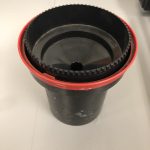Developing film was a more nerve-wracking and exciting process than I initially imagined. The film had to be loaded in the canister (the white circle) in complete darkness to ensure no light contamination. On each canister, or on the box, it will tell you the code of chemistry that you need to follow. If you have film that says ‘black and white’ but has a code of C41, it must be processed like colour film. Below contains the instructions that must be followed in the dark with the 35mm black and white film.

First, load the film into the canister, cutting off the ends. Then, place the tube through this, ensuring you have the right tube for your container. This goes into the container and the funnel gets placed on top. Turn this until is clicks, making it light tight and unable to fall out. The lid goes on last. You can then go outside to develop the film.
The video below goes through this process, as well as the chemical development. The time it takes to develop the film depends on the temperature of the water. The process as a whole takes around 40 minutes with exact measurements of the chemicals. In the development area at the University of Ottawa, we also have detailed instructions to remind us of the process as we are going through it.
Once our film is dry, we are able to hang it up in cupboards designed for the length of our film. Here, it prevents dust from touching the sensitive film. Once it is dry, it is cut up and placed into film sleeves for protection. I was very happy that I was able to get images from my first development, and I am excited to continue working with film.






Leave a Reply